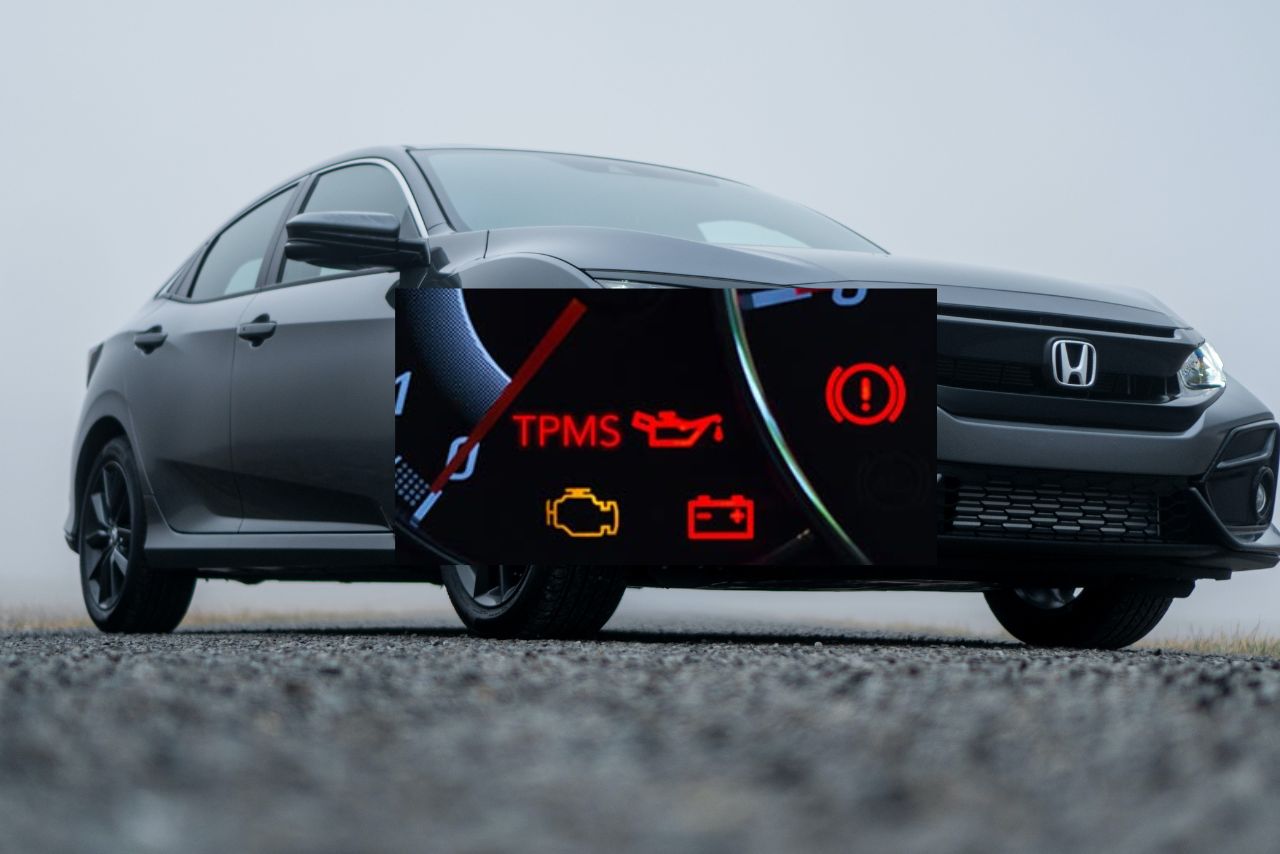The TPMS (Tire Pressure Monitoring System) is an important feature in modern vehicles, including the Honda Civic.
This system is designed to constantly monitor the tire pressure and alert the driver if it falls below the recommended level. But What Does TPMS Mean on a Honda Civic? And how do you reset or calibrate it?
The TPMS on a Honda Civic stands for Tire Pressure Monitoring System, and it serves as an essential safety feature. When the system detects low tire pressure, it will display a warning light on the dashboard, indicating which tire needs attention.
This helps to prevent accidents and reduce the risk of tire blowouts. Resetting or calibrating the TPMS is necessary when you replace your tires, rotate them, or if the system is not functioning correctly.
Understanding how to properly reset or calibrate the TPMS on your Honda Civic ensures that you maintain accurate tire pressure readings and keep your vehicle running smoothly. So, let’s dive deeper into how you can perform this task.
Table of contents
Understanding TPMS:
The Tire Pressure Monitoring System (TPMS) is an important feature on the Honda Civic that helps ensure your safety and optimize the performance of your vehicle.
In this section, we will dive into what TPMS means, how it works, and how to reset or calibrate it when necessary.
What is TPMS?
TPMS is a system designed to monitor the air pressure in your vehicle’s tires. It uses sensors located in each tire to continuously measure the tire pressure and alerts you if it detects any significant deviations from the recommended levels.
This way, TPMS helps you maintain proper tire pressure, which is crucial for your safety and the longevity of your tires.
How does TPMS work?

The TPMS sensors in your Honda Civic use radio frequency technology to transmit tire pressure data to the vehicle’s onboard computer system.
This information is then displayed on your dashboard, typically in the form of a warning light or a digital display.
The system constantly monitors the pressure in each tire, allowing you to easily identify any potential issues.
Resetting and calibrating TPMS:
Sometimes, you may need to reset or calibrate your TPMS. This can be necessary when you have replaced one or more tires, or if the system is displaying inaccurate readings. To reset TPMS on a Honda Civic, follow these steps:
- Make sure all tires are properly inflated to the recommended levels.
- Turn the ignition switch to the ON position without starting the engine.
- Press and hold the TPMS button until the TPMS indicator light blinks twice.
- Release the button, and the TPMS should be reset.
Keep in mind that the exact steps may vary slightly depending on the model year of your Honda Civic. Consult your vehicle’s owner’s manual for specific instructions.
In conclusion, understanding TPMS is essential for maintaining optimal tire pressure and ensuring your safety on the road.
How TPMS Works?
TPMS, or Tire Pressure Monitoring System, is a nifty feature in modern Honda Civics that helps you keep track of your tire pressure.
It ensures that your tires are properly inflated, which is crucial for your safety and the longevity of your tires. Here’s a breakdown of how TPMS works:
- Sensors: TPMS relies on sensors that are installed on each of your Honda Civic’s tires. These sensors constantly monitor the air pressure inside the tires and send the information to the TPMS control unit.
- Thresholds: The TPMS control unit is programmed with specific thresholds for optimal tire pressure. If the pressure in any of your tires falls below or exceeds these thresholds, the TPMS control unit will trigger a warning light on your dashboard.
- Indicator Light: When the TPMS detects a deviation in tire pressure, it illuminates a warning light on your dashboard. This light resembles an exclamation mark inside a horseshoe or may simply say “TPMS.” It serves as a visual reminder to check your tire pressure.
- Reset and Calibration: TPMS can be reset or calibrated to ensure accurate readings. This is especially important when you rotate or replace your tires to ensure that the TPMS is accurately monitoring the new tire positions.
- Driver Responsibility: While TPMS provides valuable information, it’s important to note that it doesn’t replace regular tire maintenance. It’s still your responsibility to check your tire pressure regularly, especially before long trips or in extreme weather conditions.
In a nutshell, TPMS on a Honda Civic utilizes sensors to monitor your tire pressure and alerts you when it falls outside the recommended thresholds.
| Key Points |
|---|
| TPMS relies on sensors installed on each tire |
| The TPMS control unit sets thresholds for optimal tire pressure |
| A warning light illuminates on the dashboard when pressure deviates |
| TPMS can be reset or calibrated when tires are rotated or replaced |
| Regular tire maintenance is still the driver’s responsibility |
Benefits of TPMS in Honda Civics:
Having a Tire Pressure Monitoring System (TPMS) in your Honda Civic can bring a range of benefits that enhance your driving experience and ensure your safety on the road.
Let’s take a look at some of the advantages of having TPMS in your Honda Civic:
In summary, the TPMS in your Honda Civic offers several benefits, including enhanced safety, improved fuel efficiency, extended tire lifespan, convenience, and peace of mind.
By keeping your tires properly inflated, you can enjoy a smoother and more efficient drive, all while ensuring your safety and saving money on potential tire repairs or replacements.
Common TPMS Issues:

The Tire Pressure Monitoring System (TPMS) in your Honda Civic is designed to keep you safe on the road by alerting you when your tire pressure is low.
However, like any technology, TPMS can sometimes encounter issues. Here are a few common problems you may come across:
Remember, the TPMS is a valuable safety feature that helps you maintain proper tire pressure. If you encounter any persistent issues with your TPMS, it’s always best to consult with a certified technician who can diagnose and resolve the problem for you.
| Common TPMS Issues |
|---|
| Frequent false alarms |
| TPMS warning light won’t turn off |
| Sensor battery failure |
| TPMS sensor damage |
Resetting TPMS on a Honda Civic:
If you’re wondering what TPMS means on your Honda Civic, it stands for Tire Pressure Monitoring System.
This handy feature is designed to alert you when your tire pressure is too low or too high, helping you maintain optimal tire performance and safety.
In this section, we’ll guide you through the process of resetting the TPMS on your Honda Civic.
Remember that resetting the TPMS on your Honda Civic is not a substitute for regular tire maintenance.
It’s essential to check your tire pressure regularly and inflate or deflate them as needed to ensure optimal performance and safety.
| Tire Position | Recommended Pressure |
|---|---|
| Front Left | 32 psi |
| Front Right | 32 psi |
| Rear Left | 30 psi |
| Rear Right | 30 psi |
Now that you know how to reset the TPMS on your Honda Civic, you can take control of your tire pressures and drive with confidence.
Calibrating TPMS on a Honda Civic:
Calibrating the Tire Pressure Monitoring System (TPMS) on your Honda Civic is an important maintenance task that ensures accurate tire pressure readings. By following a few simple steps, you can easily reset and calibrate the TPMS.
Here’s how you can calibrate TPMS on your Honda Civic:
It’s important to note that if the TPMS light continues to blink or stays illuminated after calibration, there might be an issue with the system or the tire pressure itself.
In such cases, it is recommended to consult a Honda dealership or a qualified mechanic for further assistance.
Calibrating the TPMS on your Honda Civic is a straightforward process that ensures your tire pressure readings are accurate and helps maintain optimal driving performance and safety.
By following these steps, you can easily reset and calibrate the TPMS, allowing you to drive with peace of mind.
Conclusion and final thoughts 💭
The TPMS (Tire Pressure Monitoring System) in a Honda Civic is an important feature that helps ensure your safety on the road.
It constantly monitors the air pressure in your tires and alerts you if any tire is underinflated or overinflated.
Here are a few key points to remember about TPMS on a Honda Civic:
- TPMS provides real-time monitoring of tire pressure, helping you avoid potential tire-related problems and accidents.
- When the TPMS warning light illuminates on your dashboard, it means that there is a tire pressure issue that needs to be addressed.
- To reset or calibrate the TPMS, you can follow these steps:
- Make sure all tires are properly inflated to the recommended pressure.
- Turn the ignition switch to the ON position.
- Press and hold the TPMS button until the TPMS indicator blinks twice.
- Drive the vehicle for a few miles at a speed above 28 mph (45 km/h) to complete the calibration process.
Remember, TPMS is not a substitute for regular tire maintenance. It is still important to check your tire pressure regularly and maintain the recommended pressure levels.
Properly inflated tires not only improve safety but also enhance fuel efficiency and prolong tire life.
In summary, the TPMS in a Honda Civic is a valuable safety feature that helps you stay informed about your tire pressure.
By understanding how to reset or calibrate it, you can ensure accurate and reliable tire pressure monitoring. So, keep an eye on your TPMS and enjoy a smoother and safer driving experience.
Latest Posts:
- Can WD-40 Remove Scratches on Cars? (Hint: Yes, but…)
- Can You Use a Drill to Polish Your Car? (We Tried it Out!)
- Should You Cover Car Scratches With Stickers? (REVEALED!)
- Buick Service Stabilitrak: (Causes & 100% Guaranteed Fix!)
- Common Holden Trax Problems (Causes & 100% Proven Fixes!)
- Jeep Commander Transmission Over Temp: (Guaranteed Fix!)











Leave a Reply